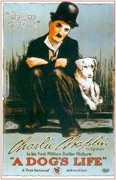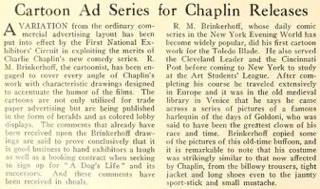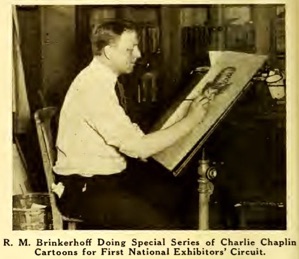A Dog‘s Life Clippings 99/146
Moving Picture World, New York, May 11, 1918.
A Dog‘s Life Posters
& Cartoon Ad Series for Chaplin Releases
A VARIATION from the ordinary commercial advertising
layout has been put into effect by the First National
Exhibitors‘ Circuit in exploiting the merits of Charlie Chaplin‘s
new comedy series. R. M. Brinkerhoff, the cartoonist,
has been engaged to cover every angle of Chaplin‘s work
with characteristic drawings designed to accentuate
the humor of the films,
(...) Motion Picture News, May 11, 1918.
Similar text in Moving Picture World, May 11, 1918.
& R. M. Brinkerhoff (creator), Little „Mary Mixup,“
Mary Was „Held to Strict Obedience“
(...) Cartoon, Evening World, New York, Nov. 7, 1918
„A laugh as well as a booking contract“
Editorial content. „To Advertise Chaplin.with Cartoons
First National Engages Brinkerhoff to Accentuate Humor
of Comedian‘s Interpretations.
A pleasing variation upon the ordinary commercial
advertising layout has been put into effect by the First
National Exhibitors‘ Circuit in exploiting the merits of Charlie
Chaplin‘s new comedy series. R. M. Brinkerhoff,
one of the best known of American cartoonists, has been
engaged to cover every angle of Chaplin‘s work with
characteristic drawings designed to accentuate the humor
of the films. Brinkerhoff‘s cartoons are not only utilized
for trade paper advertising, but are being published in the form
of heralds and as colored lobby displays.
There seems to be a sound psychological basis for the
use of cartoons in advertising the Chaplin comedies,
although the First National is the only distributing organization
to apply the principle up to date. The comments that
have already been received upon the Brinkerhoff drawings
prove conclusively that it is good business to hand
exhibitors a laugh as well as a booking contract when seeking
to sign them up for A Dog‘s Life and its successors.
R. M. Brinkerhoff‘s daily comic series in the New York
Evening World, entitled Little Mary Mix-Up, has been
widely syndicated and has made him a general favorite among
the younger generation of newspaper artists. A native
of the middle west, ,Brink‘ did his first cartoon work for the
Toledo Blade. He has also served on the staffs of the
Cleveland Leader and the Cincinnati Post before coming to New
York to take a course in advanced draughtsmanship
at the Art Students‘ League. Determined to see something
of art in its foreign aspects, he went to Paris after
completing his studies in New York, and making the French
capital his headquarters, took extended sketching trips
through England, France, Switzerland and Italy. In the old
medieval library at Venice the cartoonist says he came
across a series of pictures of a famous harlequin of the days
of Goldoni, who was said to have been the greatest
clown of his race and age. Brinkerhoff copied some of the
pictures of this old-time buffon, and it is remarkable
to note that his costume is strikingly similar to that affected
by the greatest comic artist of the present century,
the billowy trousers, tightly buttoned jacket, clongated sabots
and jaunty sport-stick differing only in minor essentials
from those associated with Charlie Chaplin‘s rise to fame.
Goldoni‘s contemporary even wore a small mustache,
and in lieu of a derby hat, crowned himself with a kind of cross
between a modern alpine and an Oriental fez.“
Similar text in Motion Picture News, May 11, 1918.
Redaktioneller Inhalt









